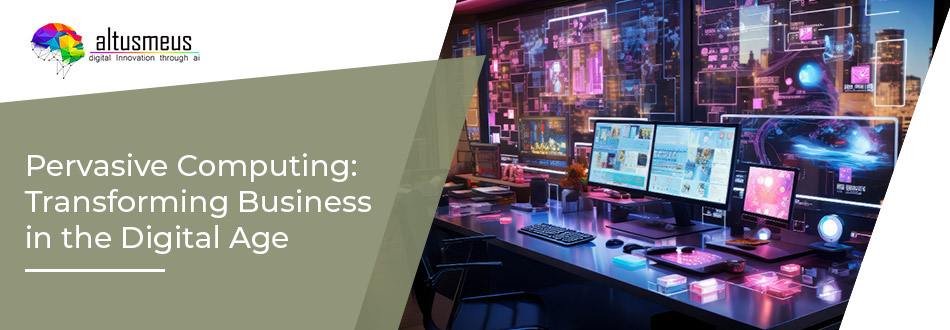In today’s rapidly evolving digital landscape, businesses face a constant challenge of staying ahead of competitors and meeting the ever-changing needs of customers. To thrive in this environment, many businesses are embracing new technologies and innovative strategies to adapt and evolve. Among these transformative technologies, pervasive computing stands out as a promising force reshaping how businesses operate and engage with customers. In this blog, we’ll explore how pervasive computing is driving digital transformation for businesses, unlocking new avenues for growth and success.
What is Pervasive Computing?
Imagine a world where technology is woven into the fabric of our everyday lives. This is the promise of pervasive computing, also known as ubiquitous computing. It’s not about bulky computers, but rather about seamlessly integrating technology into our surroundings. It will have a positive impact on everything, from local shops, parks, buses, subways and schools to even your home, making them truly smart and enhancing our experiences, while making our lives easier.
For businesses, this means embedding technology throughout their operations, for both employees and customers, from the factory to the office to the shops. The key to pervasive computing lies in a network of smart devices and sensors. These devices collect data and communicate with each other, creating an interconnected ecosystem. This allows for information to flow effortlessly, leading to smoother interactions and a more efficient environment. All of this makes different processes better, faster, correct, and frictionless.
Applications of Pervasive Computing in Business Transformation
Pervasive computing isn’t merely a buzzword; it’s revolutionizing businesses across sectors. Picture a network of smart devices seamlessly gathering data and communicating with each other, forming a robust ecosystem that streamlines operations, personalized experiences, and unlocks new potentials. Here’s how pervasive computing is reshaping industries:
Retail Revolution:
- Smart shelves: Imagine shelves that automatically track inventory levels and reorder when needed, eliminating manual checks and ensuring product availability.
- Digital signage: Interactive displays greet customers with personalized recommendations based on their preferences, enhancing the shopping experience.
- Location-based mobile apps: Apps send targeted coupons or rewards as customers pass specific store sections, creating a more engaging shopping journey.
Manufacturing Efficiency:
- IoT sensors: Real-time monitoring of machinery performance predicts potential failures, enabling preventive maintenance and minimizing downtime.
- Smart robots and cobots: Collaborative robots automate tasks alongside human workers, boosting efficiency and safety.
- Augmented reality (AR) training: AR headsets offer step-by-step instructions for complex tasks, improving training and reducing errors.
The Power of Pervasive Computing in Healthcare:
Pervasive computing’s impact on healthcare is profound. For instance, consider a diabetic patient wearing a continuous glucose monitor (CGM). This sensor transmits real-time blood sugar data to a smartphone app and doctors’ monitoring systems, enabling immediate intervention if levels deviate. Such technology empowers preventative care, enhances patient outcomes, and potentially saves lives.
Beyond these examples, pervasive computing finds applications in logistics, education, agriculture, and various sectors. The potential for innovation and transformation is immense. As technology evolves, the boundaries between physical and digital realms blur, heralding a more interconnected and intelligent future.
Outcomes of Pervasive Computing
Efficiency and Innovation:
Pervasive computing offers significant advantages in business transformation by enhancing efficiency and fostering innovation. Through the integration of digital technologies across all operational facets, companies can automate repetitive tasks, streamline processes, and enhance decision-making. For instance, predictive maintenance systems driven by pervasive computing can foresee equipment failures, thus minimizing downtime and maintenance expenses. Similarly, real-time data analytics provide valuable insights into customer behavior, market dynamics, and operational efficiency, enabling informed decision-making and facilitating business growth.
Enhanced Customer Experience:
Pervasive computing also plays a crucial role in enhancing customer experiences by providing seamless, personalized interactions across multiple touchpoints. Through the use of mobile apps, IoT devices, and smart sensors, businesses can deliver tailored products and services that meet the unique needs and preferences of individual customers. For instance, smart retail stores use beacon technology to send personalized offers and recommendations to shoppers based on their location and browsing history. Similarly, smart homes leverage pervasive computing to automate household tasks, adjust environmental settings, and enhance comfort and convenience for residents.
Challenges and Considerations
Despite its transformative potential, pervasive computing poses various challenges for businesses to navigate. These include concerns regarding investment costs, data privacy and security, interoperability, and infrastructure requirements.
For example, consider a retail business implementing pervasive computing to enhance customer experiences through personalized interactions. While this technology offers significant benefits, the upfront investment in IoT devices, data storage, and cybersecurity measures can be substantial. Additionally, ensuring data privacy and security is paramount to protect sensitive customer information from potential breaches.
Moreover, interoperability issues may arise when integrating diverse technologies into existing systems, requiring careful planning and coordination to ensure seamless operations. Similarly, addressing ethical considerations such as algorithmic bias and data discrimination is essential to uphold fairness and transparency in pervasive computing systems.
To overcome these challenges, businesses must carefully evaluate each aspect and develop robust strategies and solutions. By prioritizing data security measures, investing in scalable infrastructure, and fostering a culture of ethical responsibility, businesses can harness the full potential of pervasive computing while mitigating associated risks.
Conclusion
Pervasive computing emerges as a transformative force driving business innovation and customer experience enhancement. By seamlessly integrating digital technologies into operations, companies can achieve greater efficiency, foster innovation, and deliver personalized interactions across various touchpoints. However, challenges such as investment costs and data security concerns must be carefully addressed. Moving forward, businesses must embrace pervasive computing strategically, leveraging its potential while mitigating associated risks. With careful consideration and proactive measures, pervasive computing holds the key to unlocking new avenues for growth and success in the digital era.





